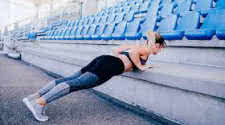Eccentric Exercise - The 3 Distinct Phases in Resistance Training

Understanding All Aspect of Training is Essential for Success
All resistance exercises have three distinct phases - the concentric, the isometric and the eccentric. During the concentric
phase of an exercise (the lifting of the weight) the muscle shortens in length. This is known as the positive portion of the
exercise. In the isometric phase (holding the weight) the muscle contracts but does not shorten or lengthen, and athletes
can handle up to 20 percent more weight relative to their one-rep max during this non-movement phase. During the eccentric
phase (lowering of the weight), the muscle lengthens or stretches, generally referred to as the negative portion. Athletes
can handle up to 40 percent more weight relative to their one-rep max in a negative contraction.
Because you can handle so much more weight when you lower a weight than when you lift it, eccentric training can generate
more tension than concentric training, thus increasing the intensity.
Research studies have shown that eccentric muscular contractions are the major factor for signaling the hypertrophic (growth)
response. This method requires a spotter and works for the bench press as follows: Starting at the top of the movement, resist
the weight as you lower it. Once you reach the deepest point in the range of motion, the spotter will help lift the weight
back up to the starting position with minimum assistance from you. Then slowly lower the weight again by yourself. Eccentric
training is possible with certain exercises only. No way could the principle be adapted for squats. In fact, if you don't
have a spotter it may be a good idea to stick to machines.
Negatives may help you smash through plateaus. However, to avoid the risk of overtraining, don't stay on a negative-only
regimen for more than three weeks. The next time you train with negatives, use 100 percent of your one-rep max and perform 2
to 4 sets of 6 to 8 reps. Do not use negatives for more than one exercise per bodypart. Give negatives a shot and you should
experience some positive growth.